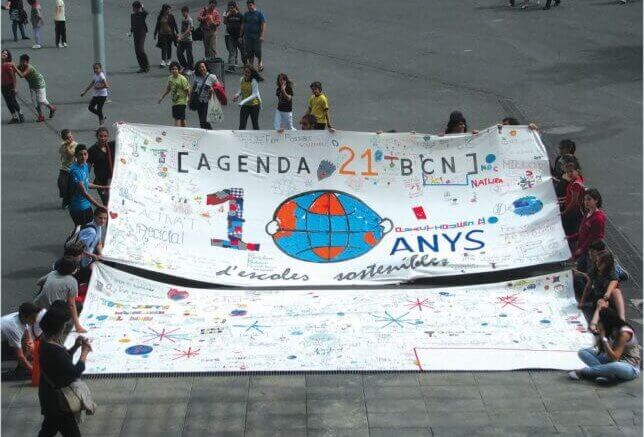Playback speed:
Origins of Sustainability
Like most, if not all, left-of-center agendas, the sustainable development concept has been with us a long time. Developed slowly and stealthily and thus largely unnoticed, the ideas began to take shape in the late 1960s, when Sweden proposed a conference to discuss man’s interaction with the environment. The outcome was the 1972 United Nations Conference on the Human Environment, which included 109 recommendations and a three-part action plan.[1] Maurice Strong was asked by UN Secretary-General U Thant to organize and lead this conference.[2]
Later, at the 1976 UN Conference on Human Settlements in Vancouver, British Columbia, participants discussed how humans could and should be redistributed throughout the world. Maurice Strong had a hand in this one too, asking Barbara Ward, whom he had made founding director of the International Institute for Environment and Development, to get involved. She wrote a book titled Home of Man, which became the theme for the conference.[3]
Ward, who became prominent in her own right, was an early champion of sustainability and spoke openly of redistributing resources from rich to poor nations.[4] She demanded that the wealthy nations donate a minimum of 1 percent of their gross domestic product to the poorer nations. This became one of the UN’s asks at the UN Conference on Environment and Development, the “Earth Summit,” held in Rio de Janeiro, Brazil, in June 1992. The follow-on Millennium Development Project initially called for “developed countries” to donate 0.7 percent of GDP every year. Predictably, now the UN says that’s not enough.[5]
The 1976 Conference envisioned redistributing not only wealth, but also land, resources, and populations worldwide, not as a matter of individual choice, but of UN-crafted policy. This is also the inspiration for the invasion of the U.S. southern border occurring today, which is being facilitated directly by the UN.[6]
The conference report states, “Human settlement policies can be powerful tools for the more equitable distribution of income and opportunities.” Furthermore:
Human settlements policies should aim to improve the condition of human settlements particularly by promoting a more equitable distribution of the benefits of development among regions; and making such benefits and public services equally accessible to all groups.[7]
The conference discussed the world in terms of “regions” rather than nations, an implicit nod to the notion of world government. Of course, “equity” is one of the three Es of sustainability. Documents from the 1976 Conference make clear that the UN believes the government should be deciding where and how everyone in the country lives. In particular, the section on land use makes explicit that UN planners seek to abolish private property:
Land, because of its unique nature and the crucial role it plays in human settlements, cannot be treated as an ordinary asset, controlled by individuals and subject to the pressures and inefficiencies of the market. Private land ownership is also a principal instrument of accumulation and concentration of wealth and therefore contributes to social injustice; if unchecked, it may become a major obstacle in the planning and implementation of development schemes. Social justice, urban renewal and development, the provision of decent dwellings-and healthy conditions for the people can only be achieved if land is used in the interests of society as a whole [emphasis added].[8]
The UN justified these measures based on expectations about population growth, various environmental policies, and of course “social justice.” These three concerns later morphed into the three “pillars” of the UN sustainability concept: environment, economy, and social equity. It is merely socialism repackaged.
Maurice Strong headed the 1992 Earth Summit, where the first set of “sustainability” goals were articulated in a document titled Agenda 21.[9] The document summarized that “Agenda 21 is a comprehensive plan of action to be taken globally, nationally and locally by organizations of the United Nations System, Governments, and Major Groups in every area in which human impacts on the environment.”[10]
A total of 178 governments signed on, including the United States under President George H.W. Bush’s signature. The Democrat-controlled U.S. House of Representatives passed Concurrent Resolution 353, which states “that the United States should assume a strong leadership role in implementing the decisions made at the Earth Summit by developing a national strategy to implement Agenda 21 and other Earth summit agreements.”
The resolution called for:
Adoption of a national strategy for environmentally sustainable development, based on an extensive process of nationwide consultations with all interested organizations and individuals; (2) the Government encouraging and facilitating means for adopting individual Agenda 21 plans of action, including the establishment of local, county, State, business, and other boards and commissions for achieving sustainable development; (3) the President establishing an effective mechanism to plan, initiate, and coordinate U.S. policy for implementing Agenda 21; and (4) policies being formulated for foreign policy and assistance to help developing countries and for domestic actions to assure appropriate action to implement Agenda 21.[11]
The U.S. Senate did not ratify Agenda 21 or vote on H.Con.Res. 353, but President Bill Clinton signed Executive Order 12852, creating the President’s Council on Sustainable Development, which operated until 1999, creating structures throughout government and promoting the same for city, county and state governments throughout the U.S.—where offices of sustainability are now the rule.
Agenda 21 also advanced in the U.S. to a great degree because “sustainability” concepts were insinuated early on into the American Planning Association’s (APA) guidelines—used almost universally by planning and zoning boards throughout the U.S. Today the APA Foundation is committed to “help steward the next generation of planners and help create more equitable, sustainable, and prosperous communities.”[12]
The agenda was rebranded in 2015 as Agenda 2030, with 17 sustainable development goals (SDG).[13] It is an all-encompassing prescription for regulating every aspect of human activity on a global scale in the interest of sustainable development. The WEF openly promotes Agenda 2030 as the ultimate goal of sustainable development.
A few recognizable sustainability concepts are “smart growth,” “walkable communities,” “15-minute neighborhoods,” “20-minute neighborhoods,” “strong communities,” “strong cities,” or “strong towns.” All seek to cram people into housing projects with all amenities within walking distance—dispensing with the need for automobiles. As the WEF now advertises, “You will own nothing and be happy.”[14]
While the supposed benefits of these developments are widely promoted, the true purposes are to abolish private autos, reduce or eliminate private property, and push people back into cities. This is both because cities are losing revenues as people flee high taxes, and because the UN-endorsed Wildlands Project (now called the Wildlands Network) seeks to return major swaths of America now occupied by suburban single-family homes and rural farms to the wild.
It should be mentioned that the Wildlands Network was founded by the late Dave Foreman, co-founder of the ecoterrorist group Earth First! Foreman pioneered using tree spikes to protest logging. Spiking caused deadly accidents, including a young man who had parts of his face ripped off.[15] Foreman paid nothing for his many acts of terrorism, despite being investigated by the FBI. He was an intimate partner in development of the sustainability agenda until his death in 2022. Foreman has said:
We must make this an insecure and inhospitable place for capitalists and their projects. We must reclaim the roads and plowed land, halt dam constructions, tear down existing dams, free shackled rivers and return to wilderness millions of acres of previously settled land.[16]
And:
Phasing out the human race will solve every problem on earth, social and environmental. . . . The optimum human population of earth is zero.[17]
In the next installment, the UN began advocating investments that incorporated environmental, social, and governance (ESG) concepts in 2006.
[1] United Nations, “Report of the United Nations Conference on the Human Environment, Stockholm, June 5–6, 1972,” 1973, https://digitallibrary.un.org/record/523249?ln=en. [2] MauriceStrong.net, “Short Biography,” accessed January 5, 2023, https://www.mauricestrong.net/index.php?option=com_content&view=article&id=15&Itemid=24. [3] David Runnalls, “Remembering Maurice Strong, Pioneering Environmental Champion,” International Institute for Environment and Development, December 4, 2015, https://www.iied.org/remembering-maurice-strong-pioneering-environmental-champion. [4] International Institute for Environment and Development, “IIED’s Founder: Barbara Ward,” August 20, 2014, https://www.iied.org/iied-founder-barbara-ward. [5] UN Economic and Social Council, “Summary of the Sixth Biennial High-Level Meeting of the Development Cooperation Forum,” July 9–18, 2018, 3/12, [6] Emily Allison, “Border Deception: How the US and UN Are Quietly Running the Border Crisis,” Epoch Times, October 13, 2022, https://www.theepochtimes.com/border-deception-how-the-us-and-un-are-quietly-running-the-border-crisis-2_4782317.html. [7] UN Conference on Human Settlements, “The Vancouver Action Plan: Recommendation A.4 More Equitable Distribution,” June 11, 1976, http://www.un-documents.net/vp-a.htm. [8] UN Conference on Human Settlements, “The Vancouver Action Plan. D. Land,” June 11, 1976, http://www.un-documents.net/vp-d.htm. [9] United Nations Sustainable Development, “United Nations Conference on Environment & Development Rio de Janeiro, Brazil, 3 to 14 June 1992: AGENDA 21,” https://sustainabledevelopment.un.org/content/documents/Agenda21.pdf. [10] UN Department of Economic and Social Affairs, Division for Sustainable Development, “Agenda 21,” accessed December 5, 2022, https://www.un.org/esa/dsd/agenda21/. [11] H.Con. Res. 353, 102nd Cong., https://www.congress.gov/bill/102nd-congress/house-concurrent-resolution/353. [12] APA Foundation, “Support the APA Foundation,” accessed December 15, 2022, https://www.planning.org/foundation/. [13] UN Department of Economic and Social Affairs: Sustainable Development, “Transforming Our World: The 2030 Agenda for Sustainable Development,” accessed November 10, 2022, https://sdgs.un.org/2030agenda. [14] Ceri Parker, “8 Predictions for the World in 2030,” World Economic Forum, November 21, 2016, https://www.weforum.org/agenda/2016/11/8-predictions-for-the-world-in-2030/. [15] Jack Anderson and Dale Van Atta, “Tree Spiking an ‘Eco-Terrorist’ Tactic,” Washington Post, March 5, 1990, https://www.washingtonpost.com/archive/local/1990/03/05/tree-spiking-an-eco-terrorist-tactic/a400944c-a3a0-4c03-ab99-afada6f44e7a/. [16] Dave Foreman, in “Dave Foreman Quotes,” AZ Quotes, accessed January 22, 2023, https://www.azquotes.com/author/26203-David_Foreman. [17] Foreman, in “Dave Foreman Quotes.”


